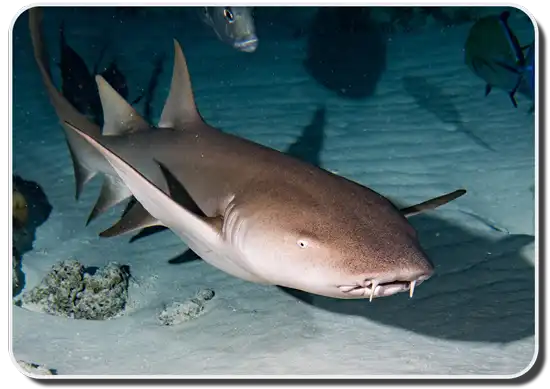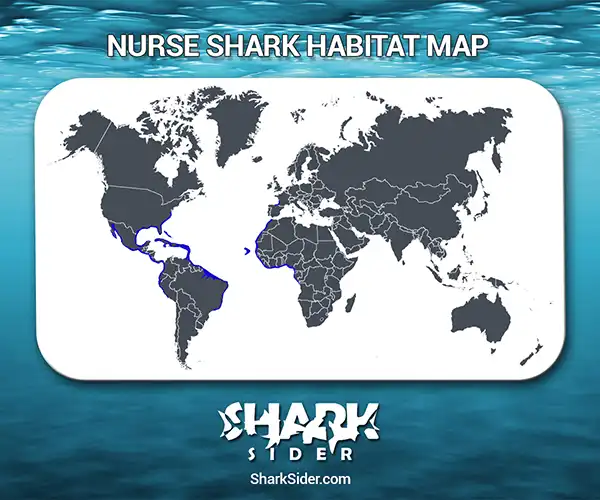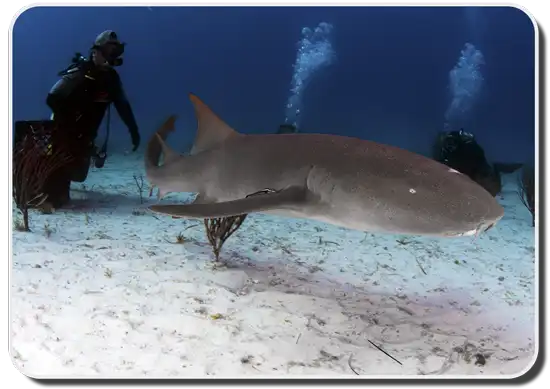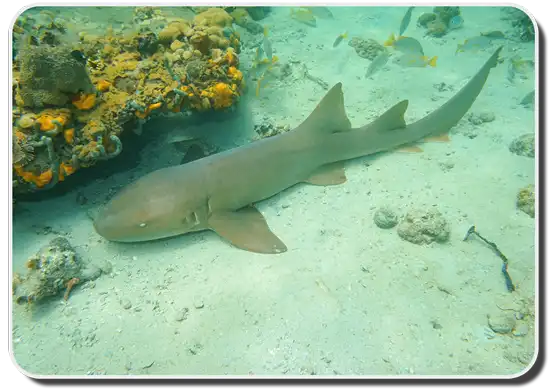The Nurse Shark, also known as the Ginglymostoma cirratum, gets its name from Greek Roots. It may come from the strange sucking sounds they make when searching for prey in the sand. As with all sharks, this giant fish is incredibly interesting and very important to the delicate marine ecosystem, especially near fragile coral reefs.
They can get quite large with a length of up to 4.5 meters (15ft) as adults. These large creatures reach weights as high as 150 kilograms (330 pounds). Typically, they live to between 25 and 35 years of age.

While most fish, including sharks, must keep moving in order to breath, Nurse Sharks can remain motionless while resting on the sea floor by facing against the flow of water and pumping the water through their mouths and gills.
Habitat
Map Of The Nurse Shark’s Habitat

As a bottom dweller, they spend much of their time on the sea floor in tropical waters around coastal shelves, reefs, and channels. They seem to enjoy the Atlantic and Pacific Oceans, especially around the Caribbean Islands. This is generally a shallow water fish.
Social Behavior
During daylight hours, they are seen in groups as large as 40. While in these groups, they mostly remain hidden under submerged ledges and around reefs. Scientists believe they stay in these groups for protection purposes only with very little dominance or hierarchy.
At night, they become more active, but also more solitary, wandering the waters alone.

Hunting Behavior
Being bottom dwellers with small mouths, they are unable to consume large fish. They hunt alone and catch their prey from the sea floor, mostly by sucking their prey into their mouths. While doing this, a Nurse Shark will inevitably make an unmistakable “slurping” or sucking sound, completely unique to this species.
The preferred prey includes sea snails, crustaceans, mollusks, and other small fish. In addition, they have been seen grazing for algae and ground corals.

Offspring
This shark species is Viviparous, meaning eggs develop within the uterus of a female until birth. The pregnancy period usually lasts about 6 months with births occurring generally in the months of June and July. After birth, an adult female Nurse Shark is unable to produce eggs for 18 months.
In average, 30 pups are born at a time. Cannibalism between pups does occur, with the larger and stronger pups eating the underdeveloped ones.
When pups are born they are only about 30cm long (12in) and have a spotted colored skin. As with Tiger Sharks, they lose the spotted patterns with age.

Human Interaction
This species is not typically hunted by commercial fishers or for sport fishing. However, some small operations capture this fish for its skin, which is used in high quality leathers. Their liver is also harvested for certain types of oils. Due to their relatively slow speeds, they are very easy to catch.
The threat to humans is very minimal. There have only been a few attacks ever recorded, and only one of those attacks was unprovoked. No fatal attacks have ever been recorded.
Nurse Sharks: Ten Facts About The Couch Potatoes Of The Sea

Nurse Sharks are a wonderful, docile species that are nicknamed the “couch potatoes of the ocean.” They are a favorite shark among divers to swim and snorkel with because you can get up close to them and still be very safe. They are also one of the most social sharks of the ocean and tend to spend time in groups just lounging on the ocean floor. They are a great species to learn about because their gentle nature and social behaviors dispel the myths that sharks are ferocious, solitary man-eaters. So here are ten interesting shark facts about this great species:
1. Scientists Aren’t Clear On Where The Name Nurse Sharks Comes From
There are a couple of theories about why these sharks are called “Nurse Sharks.” Some believe it comes from the ancient work “nusse” which means “Catshark.” While others believe the name comes from the Old English term “hurse” which means “seafloor shark.” However, other scientists believe that the name comes from the unusual sucking sound they make while hunting that resembles the suckling of a nursing baby. All of these theories are very valid and the scientific community may never know where the name came from.
2. Nurse Sharks Spend Their Days Sleeping In Cuddle Piles
Nurse Sharks are nocturnal, so they only tend to be very active at night. So they spend all day sleeping. What is really unusual about Nurse Sharks is they will slept together in very large groups. Sometimes these groups can contain up to 40 different sharks. Not only do they sleep together, they have been observed cuddling and snuggling. Scientists aren’t sure why Nurse Sharks prefer to sleep together, having a range of theories from they are very socially advanced to they sleep together as a protection from predators like Lemon and Bull Sharks.
3. Nurse Sharks Swim Very Slowly
Nurse Sharks spend a lot of their spare time just lying at the bottom of the seafloor. However, even when they do get up and move, they tend to only travel at about 1.5 mph (2.4 kph). However, when they are hunting they are capable of quick bursts of speeds that reach up to 25 mph (40 kph).
4. Nurse Sharks Low Warm Shallow Waters
Nurse sharks tend to live along the coastlines in tropical and subtropical waters. They generally spend their time in waters that are 3.2-40 ft (1-12 m) deep, though if forced to, they will hunt in deeper waters of up to 246 ft (75 m). Though it is very rare for them to hunt in deeper waters since they do not like the cold.
5. Nurse Sharks Are Pretty Large, But Not As Large As Some People Think
There have been reports of Nurse Sharks growing up to 15 ft (4.5 m) and weighing 730 lb (330 kg). However, since these reports have never been confirmed, it is assumed that most of them are either exaggerated or a case of mistaken identity because they look similar to some of the larger sharks that share their waters. However, Nurse Sharks still are a very large species of shark. They grow to 10.1 ft (3.08 m) in length and weight around 200 lb (90 kg).
6. Nurse Sharks Have Unusually Large Tail Fins
Nurse Sharks have extremely large tail fins. Their tail fins measure around 2-3 ft (0.6-0.9 m), which is one fourth of their total body length. They use this tail to help them combat their slow metabolisms. Since sharks use their tails to propel themselves through the water, the large tail of the Nurse Shark helps them swim while expelling less energy.
7. Nurse Sharks Have A Very Diverse Diet
Since Nurse Sharks tend to inhabit environments like coral reefs, mangrove islands, and sand flats where food is in an abundance, they tend to eat a lot of different kinds of prey. Nurse Sharks eat fish, other sharks, shrimp, sea urchins, octopus, stingrays, sea snakes, molluscs, tunicates, and crustaceans. So basically, like a typical couch potato, they’ll laze around and eat anything.
8. Nurse Sharks Are The Most Common Species Of Shark In The Tropics
Nurse Sharks are very populous compared to other tropical sharks. Since they have extremely low metabolisms, tending to eat 18% of other what comparable sharks eat, there can be more of them located in a smaller area without draining the food resources. Also, even though their mating cycle only happens once a year and their gestation period takes 18 months, they give birth to large litters of 21-29 pups. So they can populate areas very quickly when not under threat.
9. Nurse Sharks Are Under Threat From Humans
Nurse Sharks are often a target of commercial fishing. Their flesh is considered so delicious it is often consumed raw. It also has very tough skin so fisherman prize Nurse Sharks for their leather. Plus, since Nurse Sharks are both slow and docile, they are easy to hunt and trap. Fortunately, in some areas they are protected because they attract ecotourism revenue. However, like all sharks their numbers are dwindling.
10. Nurse Sharks Present No Threat To Humans
One of the main reasons why divers love to swim with Nurse Sharks is they are not typically aggressive towards humans. There have only been 44 recorded Nurse Shark attacks on humans in history. Most of these attacks were provoked by the humans getting too close or prodding the shark and none of them were fatal. In general, Nurse Sharks will leave humans alone if humans leave them alone.
These are just ten of the interesting shark facts about this docile species. As a favorite of divers and snorkelers, humans interact with them quite frequently. So we know quite a bit about the species compared to other sharks. Nurse Sharks are a really unique species of shark. Their docile, social nature breaks the myths of the ferocious, evil predators and instead helps us understand that there are many different kinds of sharks that swim in our oceans.
